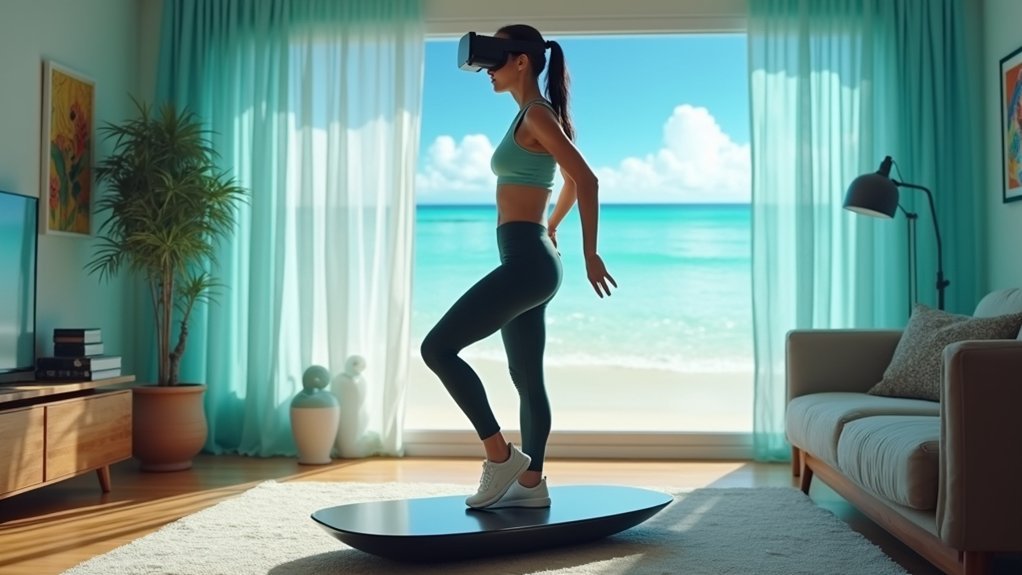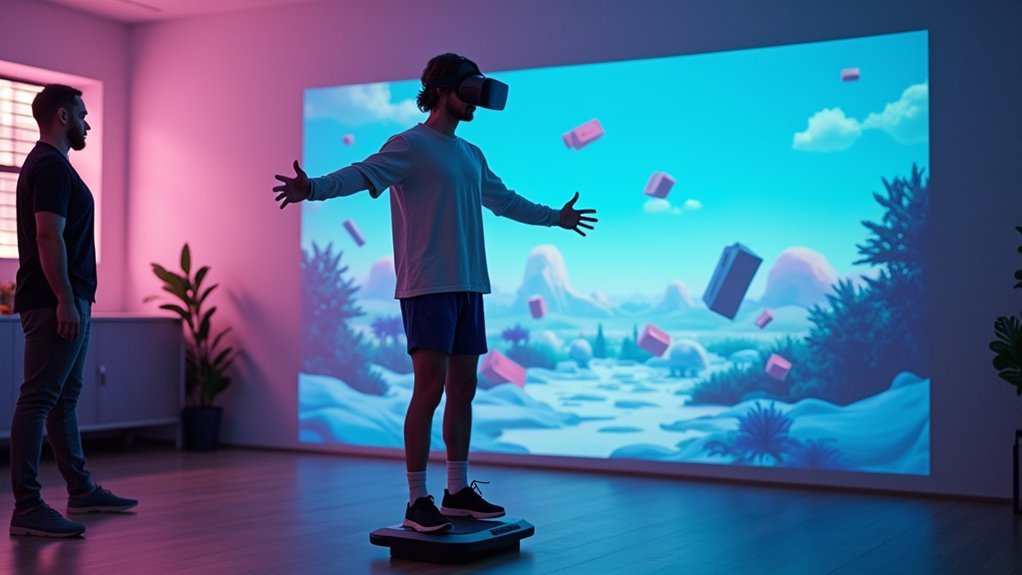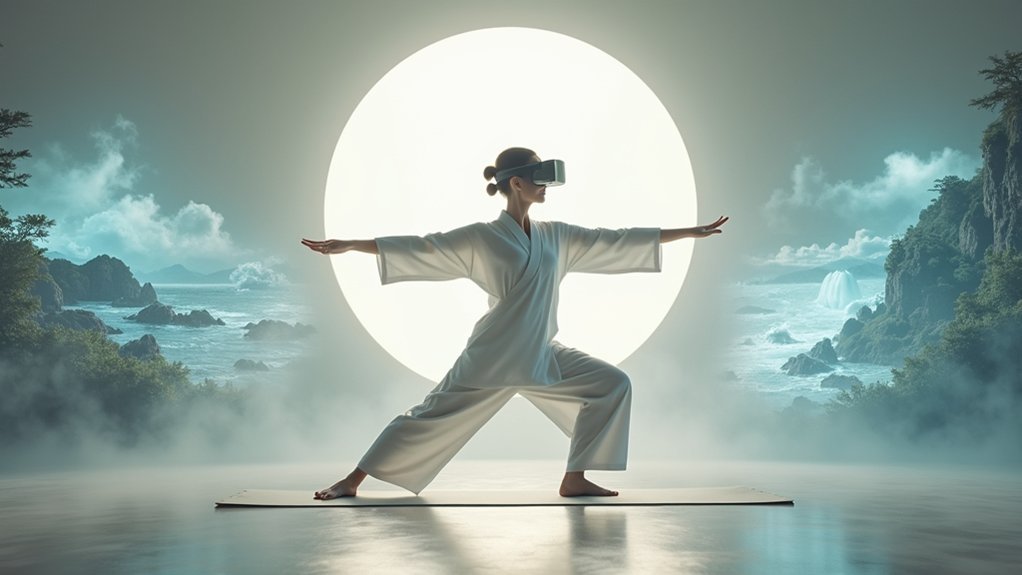You can transform your balance training with five powerful VR exercises: Wii Fit Balance Board games that target proprioception through interactive challenges, VR skating simulations that engage core muscles while mimicking real sports, virtual Timed Up-and-Go exercises proven to improve mobility in 5-8 weeks, immersive balance beam walking through dynamic virtual worlds, and VR Tai Chi programs combining ancient practices with modern technology. These evidence-based approaches reduce fall risk while boosting motivation through real-time feedback and engaging scenarios that’ll release thorough stability improvements.
Wii Fit Balance Board Training for Stability Enhancement

When you step onto the Nintendo Wii Fit Balance Board, you’re engaging with a revolutionary training system that transforms traditional balance exercises into interactive, game-based experiences.
Through yoga, balance games, and strength training activities, Wii Fit training challenges your coordination and postural control while making workouts enjoyable for all fitness levels.
These interactive exercises specifically target proprioception and core stability through dynamic movements that adapt to your abilities.
Research demonstrates that consistent participation considerably improves balance performance, particularly benefiting individuals with neurological conditions like Parkinson’s disease and multiple sclerosis.
For older adults, regular sessions measurably reduce fall risk while enhancing safety and independence.
The platform’s real-time feedback allows you to monitor progress and optimize your stability enhancement training effectively.
VR Skating and Snowboarding Simulations for Dynamic Balance Control
Building on the foundation of balance board training, VR skating and snowboarding simulations take dynamic balance control to an entirely new level through immersive, sport-specific environments.
You’ll experience realistic movements that enhance trunk and knee extensor muscle engagement while improving weight distribution and coordination. These virtual reality systems integrate split-belt treadmill technology, creating safe training conditions that boost your postural stability and gait patterns.
VR systems with split-belt treadmills create safe environments for enhancing muscle engagement and improving postural stability through realistic movement patterns.
The visual feedback and gamification elements you’ll encounter stimulate intrinsic motivation, encouraging consistent practice sessions.
Research demonstrates that VR skating and snowboarding programs deliver measurable balance improvements, making them particularly valuable for fall prevention in elderly populations.
You’re fundamentally training your dynamic balance through engaging, controlled scenarios that mimic actual sports activities.
Virtual Reality Timed Up-and-Go Exercises for Mobility Improvement

As virtual reality technology advances beyond sport-specific simulations, you’ll find that VR-enhanced Timed Up-and-Go (TUG) exercises offer a scientifically-validated approach to improving functional mobility and reducing fall risk.
These specialized rehabilitation exercises target elderly individuals who struggle with balance challenges, delivering superior results compared to conventional training methods.
Your VR TUG program should follow these evidence-based parameters:
- Session Duration: 20-45 minutes per session
- Frequency: Minimum three times weekly
- Program Length: 5-8 weeks for best results
- Focus Area: Functional mobility and fall prevention
Virtual reality enhances intrinsic motivation by making rehabilitation engaging and interactive.
You’ll experience measurable improvements in mobility metrics while enjoying the immersive experience.
Meta-analyses confirm that VR-based TUG exercises greatly outperform traditional methods, making them essential components of modern geriatric balance programs.
Immersive Balance Beam Walking in Virtual Environments
While traditional balance beam training confines you to static environments, immersive VR balance beam walking transports you into dynamic virtual worlds where you’ll navigate narrow pathways across mountain peaks, futuristic cityscapes, or underwater environments.
These virtual environments provide continuous visual feedback that enhances your postural control and stimulates greater muscle activation compared to conventional methods.
You’ll experience improved coordination as the system challenges your balance through varied terrains and obstacles. Regular practice greatly reduces your fall risk while boosting functional mobility and confidence in real-world navigation.
The engaging nature of immersive balance beam walking increases your motivation and adherence to training, ensuring consistent practice that delivers lasting improvements in your overall balance performance and stability.
VR Tai Chi and Yoga Programs for Postural Control Development

VR Tai Chi and yoga programs revolutionize postural control development by combining ancient movement practices with cutting-edge technology to create therapeutic experiences that go beyond simple balance beam exercises.
You’ll experience immersive environments that enhance sensory integration while performing mindful movements designed to improve your postural control and reduce fall risk among elderly individuals.
These programs deliver measurable improvements in balance through:
- Enhanced Balance Metrics – You’ll see significant improvements in Timed Up and Go test scores and Berg Balance Scale measurements.
- Structured Training Schedule – You’ll participate in 20-45 minute sessions at least three times weekly for ideal results.
- Dual Benefits – You’ll strengthen physical stability while boosting mental well-being through reduced anxiety and depression.
- Real-World Application – You’ll practice in simulated scenarios that translate to everyday balance challenges.
Frequently Asked Questions
What Are the Costs Associated With Implementing VR Balance Therapy Systems?
You’ll face initial hardware costs of $10,000-50,000 for VR equipment, plus ongoing expenses like software licenses, staff training, maintenance, and technical support that can add thousands annually.
Are There Any Side Effects or Contraindications for VR Balance Exercises?
You’ll experience motion sickness, eye strain, or disorientation in some cases. Don’t use VR balance exercises if you’ve severe vestibular disorders, seizure history, or recent surgery affecting your balance system.
How Long Does a Typical VR Balance Training Session Last?
You’ll typically spend 15-30 minutes in a VR balance training session. Sessions start shorter for beginners at 10-15 minutes, then gradually increase as you adapt to the technology and build endurance.
What Age Groups Benefit Most From Virtual Reality Balance Rehabilitation Programs?
You’ll find older adults over 65 benefit most from VR balance rehabilitation, as they’re at highest fall risk. However, you can also see significant improvements in stroke patients and individuals with neurological conditions.
How Does VR Balance Training Compare to Traditional Physical Therapy Methods?
You’ll find VR balance training offers more engaging, gamified experiences than traditional methods. It provides real-time feedback, customizable difficulty levels, and objective progress tracking that standard physical therapy can’t match effectively.





Leave a Reply